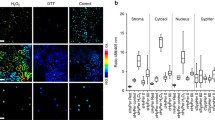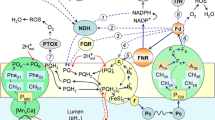Abstract
A photoacoustic pulse-modulation technique is applied for the study of a CO2-stimulated gas uptake signal in leaves (Reising and Schreiber, Photosynthe Res 31: 227–238, 1992). It is shown that this uptake signal can be substantially suppressed by application of the carbonic anhydrase inhibitor, ethoxyzolamide, to leaf discs. This inhibitor does not affect the O2-evolution signal in air or the chlorophyll fluorescence induction pattern at high CO2, when non-saturating light intensities are used. On the basis of these findings it is concluded that at least a major part of the CO2-stimulated photoacoustic uptake signal results from light-modulated CO2-solubilisation catalysed by carbonic anhydrase. Modulated CO2-solubilisation appears likely to be induced by light driven H+-translocation from the stroma into the thylakoid lumen. Comparison of the induction patterns of chlorophyll fluorescence quenching and the uptake signal suggests a correlation between membrane energisation and CO2-uptake. The importance of O2-dependent electron flow as a major cause of membrane energisation is discussed. It is proposed that in the absence of CO2 the combination of Mehler- and ascorbate peroxidase reactions does not result in a photobaric signal, as O2-uptake and O2-evolution components cancel each other. Two main conclusions, which are of considerable importance for future practical applications of the photoacoustic method, are drawn from these findings: (1) When high CO2 is applied to leaves, the photobaric uptake component may provide a unique means of monitoring the function of stromal carbonic anhydrase in vivo. (2) Brief flushing of the photoacoustic cell with air may prevent the occurrence of an uptake signal, thus allowing a straight-forward deconvolution into photothermal and O2-evolution components.
Similar content being viewed by others
References
Asada K and Badger MR (1984) Photoreduction of 18O2 and H2 18O2 with a concomitant evolution of 16O2 in intact spinach chloroplasts. Evidence for scavenging of hydrogen peroxide by peroxidase. Plant Cell Physiol 25: 1169–1179
Bults G, Horwitz BA, Malkin S and Cahen D (1982) Photoacoustic measurements of photosynthetic activities in whole leaves. Photochemistry and gas exchange. Biochim Biophys Acta 679: 452–465
Buschmann C and Prehn H (1983) In vivo photoacoustic spectra of Raphanus and Tradescantia leaves taken at different chopping frequencies of the excitation light. Photobiochem Photobiophys 5: 63–69
Canaani O and Malkin S (1984) Physiological adaptation to a newly observed low light intensity state in intact leaves, resulting in extreme imbalance in excitation energy distribution between the two photosystems. Biochim Biophys Acta 766: 525–532
Cooper TG, Filmer D, Wishnick M and Laue MD (1969) The active species of ‘CO2’ utilized by ribulose diphosphate carboxylase. J Biol Chem 244: 1081–1083
Genty B, Briantais JM and Baker NR (1989) The relationship between the quantum yield of photosynthetic electron transport and quenching of chlorophyll fluorescence. Biochim Biophys Acta 990: 87–92
Havaux M, Canaani O and Malkin S (1986) Photosynthetic responses of leaves to water stress, expressed by photoacoustic and related methods. I. Probing the photoacoustic method as an indicator for water stress in vivo. Plant Physiol 82: 827–833
Heber U and Purczeld P (1978) Substrate and product fluxes across the chloroplast envelope during bicarbonate and nitrate reduction. In: Hall DO, Coombs J and Goodwin TW (eds) Proceedings of the 4th International Congress on Photosynthesis pp 107–118. The Biochemical Society, London
Hormann H, Neubauer C, Asada K and Schreiber U (1993) Intact chloroplasts display pH 5 optimum of O2-reduction in the absence of methyl viologen: Indirect evidence for a regulatory role of superoxide protonation. Photosynth Res 37: 69–80
Hormann H, Neubauer C and Schreiber U (1994) An active Mehlerperoxidase reaction sequence prevents cyclic PS I electron transport in the presence of dioxygen in intact spinach chloroplasts. Photosynth Res 41 (3): 429–437
Kolbowski J, Reising H and Schreiber U (1990) Computercontrolled pulse modulation system for analysis of photoacoustic signals in the time domain. Photosynth Res 25: 309–316
Krause GH and Weis E (1991) Chlorophyll fluorescence and photosynthesis: The basics. Ann Rev Plant Physiol 42: 313–349
Laisk A, Oja V, Kiirats O, Raschke K and Heber U (1989) The state of the photosynthetic apparatus in leaves as analysed by rapid gas exchange and optical methods: the pH of the chloroplast stroma and activation of enzymes in vivo. Planta 177: 350–358
Lorimer GH (1981) The carboxylation and oxygenation of ribulose 1,5-bisphosphate: The primary events in photosynthesis and photorespiration. Ann Rev Plant Physiol 32: 349–389
Malkin S (1987) Fast photoacoustic transients from dark-adapted intact leaves: oxygen evolution and uptake pulses during photosynthetic induction-a phenomenology record. Planta 171: 65–72
Moroney JV, Husic HD, Tolbert NE (1985) Effects of carbonic anhydrase inhibitors on inorganic carbon accumulation by Chlamydomonas reinhardtii. Plant Physiol 79: 177–183
Oja V (1985) Estimation of pH and carbonic anhydrase activity in intact leaves on the basis of the kinetics of CO2 dissolution. In: Viil J, Grishina G and Laisk A (eds) Kinetics of Photosynthetic Carbon Metabolism in C3 Plants, Vol II, pp 104–108. Academia Nauk ESSR, Tallin
Oja V, Laisk A and Heber U (1986) Light induced alkalization of the chloroplast stroma in vivo as estimated from the CO2 capacity of intact sunflower leaves. Biochim Biophys Acta 849: 355–365
Poulet P, Cahen D and Malkin S (1983) Photoacoustic detection of photosynthetic oxygen evolution from leaves-Quantitative analysis by phase and amplitude measurements. Biochim Biophys Acta 724: 433–446
Price GD and Badger MR (1989) Ethoxyzolamide inhibition of CO2 uptake in the cyanobacterium Synechococcus PCC7942 without apparent inhibition of internal carbonic anhydrase activity. Plant Physiol 89: 44–50
Radmer RJ and Kok B (1976) Photoreduction of O2 primes and replaces CO2 assimilation. Plant Physiol 58: 336–340
Reising H and Schreiber U (1992) Pulse-modulated photoacoustic measurements reveal strong gas-uptake component at high CO2-concentrations. Photosynth Res 31: 227–238
Schreiber U, Bilger W and Schliwa U (1986) Continuous recording of photochemical and non-photochemical chlorophyll fluorescence quenching with a new type of modulation fluorometer. Photosynth Res 10: 51–62
Schreiber U and Neubauer C (1990) O2-dependent electron flow, membrane energisation and the mechanism of nonphotochemical quenching of chlorophyll fluorescence. Photosynth Res 25: 279–293
Schreiber U, Reising H and Neubauer C (1991) Contrasting pH-optima of light-driven O2- and H2O2-reduction in spinach chloroplasts as measured via chlorophyll fluorescence quenching. Z Naturforsch 46c: 635–643
Schreiber U, Bilger W and Neubauer C (1994) Chlorophyll fluorescence as a non intrusive indicator for rapid assessment of in vivo photosynthesis. Ecological Studies 100: 49–70
Snel JFH, Kooijman M and Vredenberg WJ (1990) Correlation between chlorophyll fluorescence and photoacoustic signal transients in spinach leaves. Photosynth Res 25: 259–268
Süss KH, Arkona C, Manteuffel R and Adler K (1993) Calvin cycle multienzyme complexes are bound to chloroplast thylakoid membranes of higher plants in situ. Proc Natl Acad Sci USA 90: 5514–5518
Walker DA (1987) The Use of the Oxygen Electrode and Fluorescence Probes in Simple Measurements of Photosynthesis. Oxygraphics, Sheffield
Werdan K, Heldt HW and Geller G (1972) Accumulation of bicarbonate in intact chloroplasts following a pH gradient. Biochim Biophys Acta 283: 430–441
Author information
Authors and Affiliations
Rights and permissions
About this article
Cite this article
Reising, H., Schreiber, U. Inhibition by ethoxyzolamide of a photoacoustic uptake signal in leaves: Evidence for carbonic anhydrase catalyzed CO2-solubilisation. Photosynth Res 42, 65–73 (1994). https://doi.org/10.1007/BF00019059
Received:
Accepted:
Issue Date:
DOI: https://doi.org/10.1007/BF00019059




